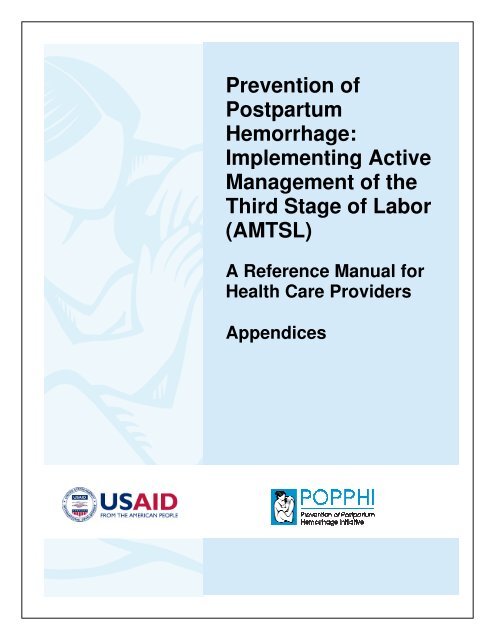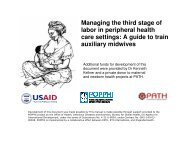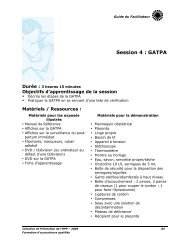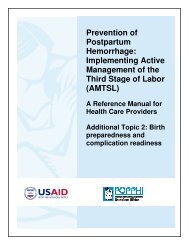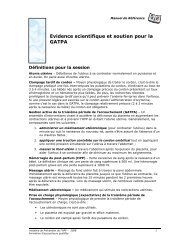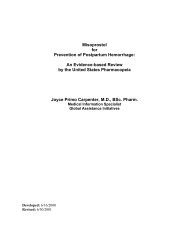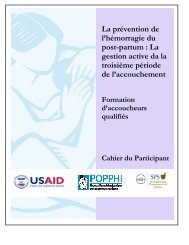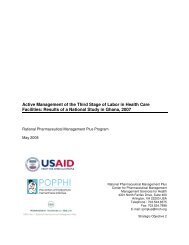Implementing Active Management of the Third Stage of Labor
Implementing Active Management of the Third Stage of Labor
Implementing Active Management of the Third Stage of Labor
You also want an ePaper? Increase the reach of your titles
YUMPU automatically turns print PDFs into web optimized ePapers that Google loves.
Prevention <strong>of</strong><br />
Postpartum<br />
Hemorrhage:<br />
<strong>Implementing</strong> <strong>Active</strong><br />
<strong>Management</strong> <strong>of</strong> <strong>the</strong><br />
<strong>Third</strong> <strong>Stage</strong> <strong>of</strong> <strong>Labor</strong><br />
(AMTSL)<br />
A Reference Manual for<br />
Health Care Providers<br />
Appendices
Table <strong>of</strong> contents<br />
Appendix A: FIGO/ICM joint statements ........................................................................3<br />
Appendix B: Uniject activation and use..................................................................... 11<br />
Appendix C: AMTSL job aid........................................................................................ 13<br />
2 Prevention <strong>of</strong> Postpartum Hemorrhage: <strong>Implementing</strong> <strong>Active</strong> <strong>Management</strong> <strong>of</strong> <strong>the</strong> <strong>Third</strong> <strong>Stage</strong> <strong>of</strong> <strong>Labor</strong>
Reference manual<br />
Appendix A: FIGO/ICM joint statements<br />
2003<br />
Joint Statement<br />
<strong>Management</strong> <strong>of</strong> <strong>the</strong> <strong>Third</strong> <strong>Stage</strong> <strong>of</strong> Labour to<br />
Prevent Post-partum Haemorrhage<br />
International Confederation <strong>of</strong> Midwives (ICM)<br />
International Federation <strong>of</strong> Gynaecologists and<br />
Obstetricians (FIGO)<br />
ICM and FIGO are key partners in global Safe Mo<strong>the</strong>rhood efforts to reduce maternal death and<br />
disability in <strong>the</strong> world. Their mission statements share a common commitment in promoting <strong>the</strong> health,<br />
human rights and well-being <strong>of</strong> all women, most especially those at greatest risk for death and<br />
disability associated with childbearing. FIGO and ICM promote evidence-based, effective interventions<br />
that, when used properly with informed consent, can reduce <strong>the</strong> incidence <strong>of</strong> maternal mortality and<br />
morbidity in <strong>the</strong> world.<br />
Severe bleeding is <strong>the</strong> single most important cause <strong>of</strong> maternal death worldwide. More than half <strong>of</strong> all<br />
maternal deaths occur within 24 hours <strong>of</strong> delivery, mostly from excessive bleeding. Every pregnant<br />
woman may face life-threatening blood loss at <strong>the</strong> time <strong>of</strong> delivery; women with anaemia are<br />
particularly vulnerable since <strong>the</strong>y may not tolerate even moderate amounts <strong>of</strong> blood loss. Every<br />
woman needs to be closely observed and, if needed, stabilized during <strong>the</strong> immediate post-partum<br />
period.<br />
Upon review <strong>of</strong> <strong>the</strong> available evidence, FIGO and ICM agree that active management <strong>of</strong> <strong>the</strong> third stage<br />
<strong>of</strong> labour is proven to reduce <strong>the</strong> incidence <strong>of</strong> post-partum haemorrhage, <strong>the</strong> quantity <strong>of</strong> blood loss,<br />
and <strong>the</strong> use <strong>of</strong> blood transfusion.<br />
<strong>Active</strong> management <strong>of</strong> <strong>the</strong> third stage <strong>of</strong> labour should be <strong>of</strong>fered to women since it reduces<br />
<strong>the</strong> incidence <strong>of</strong> post-partum haemorrhage due to uterine atony.<br />
<strong>Active</strong> management <strong>of</strong> <strong>the</strong> third stage <strong>of</strong> labour consists <strong>of</strong> interventions designed to facilitate <strong>the</strong><br />
delivery <strong>of</strong> <strong>the</strong> placenta by increasing uterine contractions and to prevent PPH by averting uterine<br />
atony. The usual components include:<br />
<br />
<br />
<br />
Administration <strong>of</strong> uterotonic agents<br />
Controlled cord traction<br />
Uterine massage after delivery <strong>of</strong> <strong>the</strong> placenta, as appropriate.<br />
Every attendant at birth needs to have <strong>the</strong> knowledge, skills and critical judgment needed to<br />
carry out active management <strong>of</strong> <strong>the</strong> third stage <strong>of</strong> labour and access to needed supplies and<br />
equipment.<br />
In this regard, national pr<strong>of</strong>essional associations have an important and collaborative role to play in:<br />
<br />
<br />
<br />
Advocacy for skilled care at birth;<br />
Dissemination <strong>of</strong> this statement to all members <strong>of</strong> <strong>the</strong> organisation and facilitation <strong>of</strong> its<br />
implementation;<br />
Public education about <strong>the</strong> need for adequate prevention and treatment <strong>of</strong> post-partum<br />
haemorrhage;<br />
Prevention <strong>of</strong> Postpartum Hemorrhage: <strong>Implementing</strong> <strong>Active</strong> <strong>Management</strong> <strong>of</strong> <strong>the</strong> <strong>Third</strong> <strong>Stage</strong> <strong>of</strong> <strong>Labor</strong> 3
Publication <strong>of</strong> <strong>the</strong> statement in national midwifery, obstetric and medical journals, newsletters<br />
and websites;<br />
Address legislative and o<strong>the</strong>r barriers that impede <strong>the</strong> prevention and treatment <strong>of</strong> postpartum<br />
haemorrhage;<br />
Incorporation <strong>of</strong> active management <strong>of</strong> <strong>the</strong> third stage <strong>of</strong> labour in national standards and<br />
clinical guidelines, as appropriate;<br />
Incorporation <strong>of</strong> active management <strong>of</strong> <strong>the</strong> third stage into pre-service and in-service<br />
curricula for all skilled birth attendants;<br />
Working with national pharmaceutical regulatory agencies, policymakers and donors to assure<br />
that adequate supplies <strong>of</strong> uterotonics and injection equipment are available.<br />
MANAGEMENT OF THE THIRD STAGE OF LABOUR TO PREVENT POST-PARTUM<br />
HAEMORRHAGE<br />
HOW TO USE UTEROTONIC AGENTS<br />
<br />
<br />
<br />
<br />
Within one minute <strong>of</strong> <strong>the</strong> delivery <strong>of</strong> <strong>the</strong> baby, palpate <strong>the</strong> abdomen to rule out <strong>the</strong> presence<br />
<strong>of</strong> an additional baby(s) and give oxytocin 10 units IM. Oxytocin is preferred over o<strong>the</strong>r<br />
uterotonic drugs because it is effective 2-3 minutes after injection, has minimal side effects<br />
and can be used in all women.<br />
If oxytocin is not available, o<strong>the</strong>r uterotonics can be used such as: ergometrine 0.2 mg IM,<br />
syntometrine (1 ampoule) IM or misoprostol 400-600 mcg orally. Oral administration <strong>of</strong><br />
misoprostol should be reserved for situations when safe administration and/or appropriate<br />
storage conditions for injectable oxytocin and ergot alkaloids are not possible.<br />
Uterotonics require proper storage:<br />
o<br />
o<br />
o<br />
Ergometrine: 2-8° C and protect from light and from freezing.<br />
Misoprostol: room temperature, in a closed container.<br />
Oxytocin: 15-30° C, protect from freezing<br />
Counselling on <strong>the</strong> side effects <strong>of</strong> <strong>the</strong>se drugs should be given.<br />
Warning! Do not give ergometrine or syntometrine (because it contains ergometrine) to<br />
women with pre-eclampsia, eclampsia or high blood pressure.<br />
HOW TO DO CONTROLLED CORD TRACTION<br />
<br />
<br />
<br />
<br />
<br />
Clamp <strong>the</strong> cord close to <strong>the</strong> perineum (once pulsation stops in a healthy newborn) and hold in<br />
one hand.<br />
Place <strong>the</strong> o<strong>the</strong>r hand just above <strong>the</strong> woman’s pubic bone and stabilize <strong>the</strong> uterus by applying<br />
counter-pressure during controlled cord traction.<br />
Keep slight tension on <strong>the</strong> cord and await a strong uterine contraction (2-3 minutes).<br />
With <strong>the</strong> strong uterine contraction, encourage <strong>the</strong> mo<strong>the</strong>r to push and very gently pull<br />
downward on <strong>the</strong> cord to deliver <strong>the</strong> placenta. Continue to apply counter-pressure to <strong>the</strong><br />
uterus.<br />
If <strong>the</strong> placenta does not descend during 30-40 seconds <strong>of</strong> controlled cord traction do not<br />
continue to pull on <strong>the</strong> cord:<br />
o<br />
o<br />
Gently hold <strong>the</strong> cord and wait until <strong>the</strong> uterus is well contracted again;<br />
With <strong>the</strong> next contraction, repeat controlled cord traction with counter-pressure.<br />
4 Prevention <strong>of</strong> Postpartum Hemorrhage: <strong>Implementing</strong> <strong>Active</strong> <strong>Management</strong> <strong>of</strong> <strong>the</strong> <strong>Third</strong> <strong>Stage</strong> <strong>of</strong> <strong>Labor</strong>
Reference manual<br />
Never apply cord traction (pull) without applying counter traction (push) above <strong>the</strong> pubic<br />
bone on a well-contracted uterus.<br />
<br />
<br />
<br />
As <strong>the</strong> placenta delivers, hold <strong>the</strong> placenta in two hands and gently turn it until <strong>the</strong> membranes<br />
are twisted. Slowly pull to complete <strong>the</strong> delivery.<br />
If <strong>the</strong> membranes tear, gently examine <strong>the</strong> upper vagina and cervix wearing sterile/disinfected<br />
gloves and use a sponge forceps to remove any pieces <strong>of</strong> membrane that are present.<br />
Look carefully at <strong>the</strong> placenta to be sure none <strong>of</strong> it is missing. If a portion <strong>of</strong> <strong>the</strong> maternal<br />
surface is missing or <strong>the</strong>re are torn membranes with vessels, suspect retained placenta<br />
fragments and take appropriate action (ref Managing Complications in Pregnancy and<br />
Childbirth).<br />
HOW TO DO UTERINE MASSAGE<br />
<br />
<br />
<br />
Immediately massage <strong>the</strong> fundus <strong>of</strong> <strong>the</strong> uterus until <strong>the</strong> uterus is contracted.<br />
Palpate for a contracted uterus every 15 minutes and repeat uterine massage as needed<br />
during <strong>the</strong> first 2 hours.<br />
Ensure that <strong>the</strong> uterus does not become relaxed (s<strong>of</strong>t) after you stop uterine massage.<br />
In all <strong>of</strong> <strong>the</strong> above actions, explain <strong>the</strong> procedures and actions to <strong>the</strong> woman and her<br />
family. Continue to provide support and reassurance throughout.<br />
References:<br />
WHO, UNFPA, UNICEF, World Bank. Managing Complications in Pregnancy and Childbirth.<br />
WHO/RHR/00.7, 2000.<br />
Elbourne DR, Prendiville WJ, Carroli G, Wood J, McDonald S. Prophylactic use <strong>of</strong> oxytocin in <strong>the</strong> third<br />
stage <strong>of</strong> labour. In: The Cochran Library, Issue 3, 2003. Oxford. Update S<strong>of</strong>tware.<br />
Prendiville WJ, Elbourne D, McDonald S. <strong>Active</strong> vs. expectant management in <strong>the</strong> third stage <strong>of</strong><br />
labour. In: The Cochrane Library, Issue 3, 2003. Oxford: Update S<strong>of</strong>tware.<br />
Joy SD, Sanchez-Ramos L, Kaunitz AM. Misoprostol use during <strong>the</strong> third stage <strong>of</strong> labor. Int J<br />
Gynecol Obstet 2003;82:143-152.<br />
Prevention <strong>of</strong> Postpartum Hemorrhage: <strong>Implementing</strong> <strong>Active</strong> <strong>Management</strong> <strong>of</strong> <strong>the</strong> <strong>Third</strong> <strong>Stage</strong> <strong>of</strong> <strong>Labor</strong> 5
November 2006<br />
Prevention and Treatment <strong>of</strong> Post-partum Haemorrhage<br />
New Advances for Low Resource Settings<br />
Joint Statement<br />
International Confederation <strong>of</strong> Midwives (ICM)<br />
International Federation <strong>of</strong> Gynaecology and Obstetrics (FIGO)<br />
The International Confederation <strong>of</strong> Midwives (ICM) and <strong>the</strong> International Federation <strong>of</strong> Gynaecology<br />
and Obstetrics (FIGO) are key partners in <strong>the</strong> global effort to reduce maternal death and disability<br />
around <strong>the</strong> world. Their mission statements share a common commitment in promoting <strong>the</strong> health,<br />
human rights and well-being <strong>of</strong> all women, most especially those at greatest risk for death and<br />
disability associated with childbearing. FIGO and ICM promote evidence-based interventions that,<br />
when used properly with informed consent, can reduce <strong>the</strong> incidence <strong>of</strong> maternal morbidity and<br />
mortality.<br />
This statement reflects <strong>the</strong> current (2006) state-<strong>of</strong>-<strong>the</strong>-art and science <strong>of</strong> prevention and treatment <strong>of</strong><br />
post-partum haemorrhage (PPH) in low resource settings. It incorporates new research evidence that<br />
has become available since <strong>the</strong> 2003 publication <strong>of</strong> <strong>the</strong> first FIGO/ICM Joint Statement: <strong>Management</strong><br />
<strong>of</strong> <strong>the</strong> <strong>Third</strong> <strong>Stage</strong> <strong>of</strong> Labour to Prevent Post-partum Haemorrhage. 1<br />
Approximately 30 per cent <strong>of</strong> direct maternal deaths worldwide are due to haemorrhage, mostly in <strong>the</strong><br />
post-partum period. 2 Most maternal deaths due to PPH occur in developing countries in settings (both<br />
hospital and community) where <strong>the</strong>re are no birth attendants or where birth attendants lack <strong>the</strong><br />
necessary skills or equipment to prevent and manage PPH and shock. The Millennium Development<br />
Goal <strong>of</strong> reducing <strong>the</strong> maternal mortality ratio by 75 per cent by 2015 3 will remain beyond our reach<br />
unless we confront <strong>the</strong> problem <strong>of</strong> PPH in <strong>the</strong> developing world as a priority.<br />
Both ICM and FIGO endorse international recommendations that emphasise <strong>the</strong> provision <strong>of</strong> skilled<br />
birth attendants and improved obstetric services as central to efforts to reduce maternal and neonatal<br />
mortality. Such policies reflect what should be a basic right for every woman. Addressing PPH will<br />
require a combination <strong>of</strong> approaches to expand access to skilled care and, at <strong>the</strong> same time, extend<br />
life-saving interventions along a continuum <strong>of</strong> care from community to hospital. The different settings<br />
where women deliver along this continuum require different approaches to PPH prevention and<br />
treatment.<br />
Call to Action<br />
Despite Safe Mo<strong>the</strong>rhood activities since 1987, women are still dying in childbirth. Women living in<br />
low resource settings are most vulnerable due to concurrent disease, poverty, discrimination and<br />
limited access to health care. The ICM and FIGO have a central role to play in improving <strong>the</strong> capacity<br />
<strong>of</strong> national obstetric societies and midwifery associations to reduce maternal mortality through safe,<br />
effective, feasible and sustainable approaches to reducing deaths and disabilities resulting from PPH.<br />
In turn, national obstetric and midwifery associations must lead <strong>the</strong> effort to implement <strong>the</strong><br />
approaches described in this statement. Pr<strong>of</strong>essional associations can mobilise to:<br />
<br />
<br />
<br />
<br />
Lobby governments to ensure healthcare for all women;<br />
Advocate for every woman to have a midwife, doctor or o<strong>the</strong>r skilled attendant at birth;<br />
Disseminate this statement to all members through all available means including publication in<br />
national newsletters or pr<strong>of</strong>essional journals;<br />
Educate <strong>the</strong>ir members, o<strong>the</strong>r health care providers, policy makers, and <strong>the</strong> public about <strong>the</strong><br />
approaches described in this statement and about <strong>the</strong> need for skilled care during childbirth;<br />
6 Prevention <strong>of</strong> Postpartum Hemorrhage: <strong>Implementing</strong> <strong>Active</strong> <strong>Management</strong> <strong>of</strong> <strong>the</strong> <strong>Third</strong> <strong>Stage</strong> <strong>of</strong> <strong>Labor</strong>
Reference manual<br />
<br />
<br />
<br />
<br />
Address legislative and regulatory barriers that impede access to life-saving care, especially policy<br />
barriers that currently prohibit midwives and o<strong>the</strong>r birth attendants from administering uterotonic<br />
drugs;<br />
Ensure that all birth attendants have <strong>the</strong> necessary training, appropriate to <strong>the</strong> settings where <strong>the</strong>y<br />
work, to safely administer uterotonic drugs and implement o<strong>the</strong>r approaches described in this<br />
statement and that uterotonics are available in sufficient quantity to meet <strong>the</strong> need;<br />
Call upon national regulatory agencies and policy makers to approve misoprostol for PPH<br />
prevention and treatment;<br />
Incorporate <strong>the</strong> recommendations from this statement into current guidelines, competencies and<br />
curricula.<br />
We also call upon funding agencies to help underwrite initiatives aimed at reducing PPH through <strong>the</strong> use<br />
<strong>of</strong> cost-effective, resource- appropriate interventions.<br />
Prevention <strong>of</strong> Post-partum Haemorrhage<br />
Pregnant women may face life-threatening blood loss at <strong>the</strong> time <strong>of</strong> delivery. Anaemic women are<br />
more vulnerable to even moderate amounts <strong>of</strong> blood loss. Fortunately, most PPH can be prevented.<br />
Different approaches may be employed depending on <strong>the</strong> setting and availability <strong>of</strong> skilled birth<br />
attendants and supplies.<br />
<strong>Active</strong> <strong>Management</strong> <strong>of</strong> <strong>the</strong> <strong>Third</strong> <strong>Stage</strong> <strong>of</strong> Labour (AMTSL)<br />
Data support <strong>the</strong> use <strong>of</strong> active management <strong>of</strong> <strong>the</strong> third stage <strong>of</strong> labour (AMTSL) by all skilled birth<br />
attendants regardless <strong>of</strong> where <strong>the</strong>y practice. AMTSL reduces <strong>the</strong> incidence <strong>of</strong> PPH, <strong>the</strong> quantity <strong>of</strong> blood<br />
loss and <strong>the</strong> use <strong>of</strong> blood transfusion 4 , and thus should be included in any programme <strong>of</strong> interventions<br />
aimed at reducing deaths from PPH.<br />
The usual components <strong>of</strong> AMTSL include:<br />
<br />
<br />
<br />
Administration <strong>of</strong> oxytocin* or ano<strong>the</strong>r uterotonic drug within one minute after <strong>the</strong> birth <strong>of</strong> <strong>the</strong><br />
baby<br />
Controlled cord traction**<br />
Uterine massage after delivery <strong>of</strong> <strong>the</strong> placenta as appropriate.<br />
(For more detailed information on AMTSL, see <strong>the</strong> FIGO/ICM Joint Statement: <strong>Management</strong> <strong>of</strong> <strong>the</strong> <strong>Third</strong><br />
<strong>Stage</strong> <strong>of</strong> Labour to Prevent Post- partum Haemorrhage.)<br />
Misoprostol and <strong>the</strong> Prevention <strong>of</strong> Post-Partum Haemorrhage<br />
In situations where no oxytocin is available or birth attendants’ skills are limited, administering<br />
misoprostol soon after <strong>the</strong> birth <strong>of</strong> <strong>the</strong> baby reduces <strong>the</strong> occurrence <strong>of</strong> haemorrhage 7, 8 . The most<br />
common side effects are transient shivering and pyrexia. Education <strong>of</strong> women and birth attendants in<br />
<strong>the</strong> proper use <strong>of</strong> misoprostol is essential.<br />
The usual components <strong>of</strong> giving misoprostol include:<br />
<br />
<br />
<br />
Administration <strong>of</strong> 600 micrograms (mcg) misoprostol orally or sublingually after <strong>the</strong> birth <strong>of</strong> <strong>the</strong><br />
baby***<br />
Controlled cord traction ONLY when a skilled attendant is present at <strong>the</strong> birth<br />
Uterine massage after <strong>the</strong> delivery <strong>of</strong> <strong>the</strong> placenta as appropriate.<br />
*The preferred storage <strong>of</strong> oxytocin is refrigeration but it may be stored at temperatures up to 300C up<br />
to three months without significant loss <strong>of</strong> potency. 5<br />
**Delaying cord clamping by one to three minutes reduces anaemia in <strong>the</strong> newborn. 6<br />
***Data from two trials comparing misoprostol with placebo show that misoprostol 600 mcg given orally or<br />
sublingually reduces PPH with or without controlled cord traction or use <strong>of</strong> uterine massage. 7,8<br />
Prevention <strong>of</strong> Postpartum Hemorrhage: <strong>Implementing</strong> <strong>Active</strong> <strong>Management</strong> <strong>of</strong> <strong>the</strong> <strong>Third</strong> <strong>Stage</strong> <strong>of</strong> <strong>Labor</strong> 7
<strong>Management</strong> <strong>of</strong> <strong>the</strong> <strong>Third</strong> <strong>Stage</strong> <strong>of</strong> Labour in <strong>the</strong> Absence <strong>of</strong> Uterotonic Drugs<br />
In some settings <strong>the</strong>re will be no uterotonics available due to interruptions <strong>of</strong> supplies or <strong>the</strong> setting <strong>of</strong><br />
birth. In <strong>the</strong> absence <strong>of</strong> current evidence, ICM and FIGO recommend that when no uterotonic drugs are<br />
available to ei<strong>the</strong>r <strong>the</strong> skilled or non-skilled birth attendant, management <strong>of</strong> <strong>the</strong> third stage <strong>of</strong> labour<br />
includes <strong>the</strong> following components:<br />
<br />
<br />
<br />
<br />
Waiting for signs <strong>of</strong> separation <strong>of</strong> <strong>the</strong> placenta (cord leng<strong>the</strong>ning, small blood loss, uterus firm and<br />
globular on palpation at <strong>the</strong> umbilicus)<br />
Encouraging maternal effort to bear down with contractions and, if necessary, to encourage an<br />
upright position<br />
Controlled cord traction is not recommended in <strong>the</strong> absence <strong>of</strong> uterotonic drugs, or prior to signs<br />
<strong>of</strong> separation <strong>of</strong> <strong>the</strong> placenta, as this can cause partial placental separation, a ruptured cord,<br />
excessive bleeding and uterine inversion<br />
Uterine massage after <strong>the</strong> delivery <strong>of</strong> <strong>the</strong> placenta as appropriate.<br />
Treatment <strong>of</strong> Post-partum Haemorrhage<br />
Even with major advances in prevention <strong>of</strong> PPH, some women will still require treatment for<br />
excessive bleeding. Timely and appropriate referral and transfer to basic or comprehensive<br />
Emergency Obstetric Care (EmOC) facilities for treatment is essential to saving lives <strong>of</strong> women.<br />
Currently, <strong>the</strong> standard <strong>of</strong> care in basic EmOC facilities includes administration <strong>of</strong> IV/IM uterotonic<br />
drugs and manual removal <strong>of</strong> <strong>the</strong> placenta and retained products <strong>of</strong> conception; comprehensive<br />
emergency obstetrical care facilities would also include blood transfusion and/or surgery. 9<br />
Community-based Emergency Care – Home-based Life-saving Skills (HBLSS)<br />
Anyone who attends a delivery can be taught simple home-based life-saving skills. Community-based<br />
obstetric first aid with home-based life- saving skills (HBLSS) is a family and community-focused<br />
programme that aims to increase access to basic life-saving measures and decrease delays in<br />
reaching referral facilities. Family and community members are taught techniques such as uterine<br />
fundal massage and emergency preparedness. Field tests suggest that HBLSS can be a useful adjunct<br />
in a comprehensive PPH prevention and treatment programme. 10 Key to <strong>the</strong> effectiveness <strong>of</strong><br />
treatment is <strong>the</strong> early identification <strong>of</strong> haemorrhage and prompt initiation <strong>of</strong> treatment.<br />
Misoprostol in <strong>the</strong> Treatment <strong>of</strong> Post-partum Haemorrhage<br />
While <strong>the</strong>re is less information about <strong>the</strong> effect <strong>of</strong> misoprostol for treatment <strong>of</strong> PPH, it may be<br />
appropriate for use in low resource settings and has been used alone, in combination with oxytocin,<br />
and as a last resort for PPH treatment. In <strong>the</strong> published literature, a variety <strong>of</strong> doses and routes <strong>of</strong><br />
administration have shown promising results. 11 In home births without a skilled attendant, misoprostol<br />
may be <strong>the</strong> only technology available to control PPH. An optimal treatment regimen has not yet been<br />
determined. One published study on treatment <strong>of</strong> PPH found that 1000 mcg rectally significantly<br />
reduces <strong>the</strong> need for additional interventions. 12 Studies are ongoing to determine <strong>the</strong> most effective<br />
and safe dose for <strong>the</strong> treatment <strong>of</strong> PPH. A rare case <strong>of</strong> non-fatal hyperpyrexia has been reported after<br />
800 mcg <strong>of</strong> oral misoprostol. 13<br />
NOTE: Repeated doses <strong>of</strong> misoprostol are not recommended.<br />
8 Prevention <strong>of</strong> Postpartum Hemorrhage: <strong>Implementing</strong> <strong>Active</strong> <strong>Management</strong> <strong>of</strong> <strong>the</strong> <strong>Third</strong> <strong>Stage</strong> <strong>of</strong> <strong>Labor</strong>
Reference manual<br />
Innovative techniques<br />
O<strong>the</strong>r promising techniques appropriate for low resource settings for assessment and treatment <strong>of</strong> PPH<br />
include easy and accurate blood loss measurement, 14, 15 oxytocin in Uniject, 16 uterine tamponade, 17 and<br />
<strong>the</strong> anti-shock garment. 18 These innovations are still under investigation for use in low resource<br />
settings but may prove programmatically important, especially for women living far from skilled care.<br />
Research Needs<br />
Important strides have been made in identifying life-saving approaches and interventions appropriate<br />
for PPH prevention and treatment in low resource settings. The field is rapidly evolving and <strong>the</strong><br />
following issues have been identified as priorities for fur<strong>the</strong>r research in low resource settings:<br />
<br />
<br />
<br />
<br />
<br />
Determine <strong>the</strong> optimal dose and route <strong>of</strong> misoprostol for prevention and treatment <strong>of</strong> PPH that<br />
will still be highly effective but will minimize <strong>the</strong> risk <strong>of</strong> side effects.<br />
Determine <strong>the</strong> most effective method <strong>of</strong> third stage management when no uterotonics are<br />
available.<br />
Assess <strong>the</strong> impact <strong>of</strong> better measurement <strong>of</strong> blood loss (e.g. with a calibrated drape or o<strong>the</strong>r<br />
means) on birth attendants’ delivery practices.<br />
Assess options for treatment <strong>of</strong> PPH in lower-level (basic EmOC) facilities, in particular, uterine<br />
tamponade and <strong>the</strong> anti-shock garment.<br />
Identify <strong>the</strong> most efficient and effective means <strong>of</strong> teaching and supporting <strong>the</strong> skills needed by<br />
birth attendants and for community empowerment to address PPH.<br />
References<br />
1. International Confederation <strong>of</strong> Midwives, International Federation <strong>of</strong> Gynaecology and Obstetrics.<br />
Joint statement management <strong>of</strong> <strong>the</strong> third stage <strong>of</strong> labour to prevent post-partum haemorrhage.<br />
The Hague: ICM; London: FIGO; 2003. Available at:<br />
http://www.internationalmidwives.org/modules/ContentExpress/img_repository/final%20joint%20<br />
statement%20active%20manange ment-eng%20with%20logo.pdf or<br />
http://www.figo.org/content/PDF/PPH%20Joint%20Statement.pdf. Retrieved October 12, 2006.<br />
2. Khan KS, Wojdyla D, Say L, Gulmezoglu AM, Van Look PF. WHO analysis <strong>of</strong> causes <strong>of</strong> maternal<br />
death: a systematic review. Lancet 2006;367:1066-74. DOI:10.1016/S0140-6736(06)68397-9.<br />
3. United Nations. Millennium Development Goals. New York (NY): UN; 2000. Available at:<br />
http://www.un.org/millenniumgoals. Retrieved October 12, 2006.<br />
4. Prendiville WJ, Elbourne D, McDonald S. <strong>Active</strong> versus expectant management in <strong>the</strong> third stage <strong>of</strong><br />
labour. Cochrane Database <strong>of</strong> Systematic Reviews 2000, Issue 3. Art. No.: CD000007. DOI:<br />
10.1002/14651858.CD000007.<br />
5. Hogerzeil HV, Walker GJ, de Goeje MJ. Stability <strong>of</strong> injectable oxytocics in tropical climates: results<br />
<strong>of</strong> field surveys and simulation studies on ergometrine, methylergometrine, and oxytocin. Geneva:<br />
Action Programme on Essential Drugs and Vaccines, World Health Organization; 1993. WHO<br />
Publication No. WHO/DPA/93.6.<br />
6 Ceriani Cernandas JM, Carroli G, Pellegrini L, Otano L, Ferreira M, Ricci C, et al. The effect <strong>of</strong> timing<br />
<strong>of</strong> cord clamping on neonatal venous hematocrit values and clinical outcome at term: a randomized,<br />
controlled trial. Pediatrics 2006;117:e779-86.<br />
7. Derman RJ, Kodkany BS, Goudar SS, Gellar SE, Naik VA, Bellad M, et al. Oral misoprostol in<br />
preventing postpartum haemorrhage in resource-poor communities: a randomised controlled trial.<br />
Lancet 2006;368:1248-53.<br />
8. Høj L, Cardoso P, Nielsen BB, Hvidman L, Nielsen J, Aaby P. Effect <strong>of</strong> sublingual misoprostol on<br />
severe postpartum haemorrhage in a primary health centre in Guinea-Bissau: randomised double<br />
blind clinical trial. BMJ 2005;331:723.<br />
Prevention <strong>of</strong> Postpartum Hemorrhage: <strong>Implementing</strong> <strong>Active</strong> <strong>Management</strong> <strong>of</strong> <strong>the</strong> <strong>Third</strong> <strong>Stage</strong> <strong>of</strong> <strong>Labor</strong> 9
9. United Nations Population Fund. Emergency obstetric care: checklist for planners. New York (NY):<br />
UNFPA; 2003. Available at: http://www.unfpa.org/upload/lib_pub_file/<br />
150_filename_checklist_MMU.pdf. Retrieved October 12, 2006.<br />
10. Sibley L, Buffington ST, Haileyesus D. The American College <strong>of</strong> Nurse Midwives’ Home-based<br />
lifesaving skills program: a review <strong>of</strong> <strong>the</strong> Ethiopia field test [published erratum appears in J<br />
Midwifery Womens Health 2004;49(6):following table <strong>of</strong> contents]. J Midwifery Womens Health<br />
2004;49:320-8.<br />
11. H<strong>of</strong>meyr GJ, Walraven G, Gulmezoglu AM, Maholwana B, Alfirevic Z, Villar J. Misoprostol to treat<br />
postpartum haemorrhage: a systematic review. BJOG 2005;112:547-53.<br />
12. Prata N, Mbaruku G, Campbell M, Potts M, Vahidnia E. Controlling postpartum hemorrhage after<br />
home births in Tanzania. Int J Gynaecol Obstet 2005;90:51-5.<br />
13. Chong YS, Chua S, Arulkumaran S. Severe hyper<strong>the</strong>rmia following oral misoprostol in <strong>the</strong><br />
immediate postpartum period. Obstet Gynecol 1997;90:703-4.<br />
14. Tourne G, Collet F, Lasnier P, Seffert P. Usefulness <strong>of</strong> a collecting bag for <strong>the</strong> diagnosis <strong>of</strong><br />
postpartum haemorrhage [French]. J Gynecol Obstet Biol Reprod (Paris) 2004;33:229-34.<br />
15. Prata N, Mbaruku G, Campbell M. Using <strong>the</strong> kanga to measure post-partum blood loss. Int J<br />
Gynaecol Obstet 2005;89:49-50.<br />
16. Tsu VD, Sutanto A, Vaidya K, C<strong>of</strong>fey P, Widjaya A. Oxytocin in prefilled Uniject injection devices for<br />
managing third-stage labor in Indonesia. Int J Gynaecol Obstet 2003;83:103-11.<br />
17. Condous GS, Arulkumaran S, Symonds I, Chapman R, Sinha A, Razvi K.The “tamponade test” in<br />
<strong>the</strong> management <strong>of</strong> massive postpartum hemorrhage. Obstet Gynecol 2003;101:767-72.<br />
18. Miller S, Hamza S, Bray EH, Lester F, Nada K, Gibson R, et al. First aid for obstetric haemorrhage:<br />
<strong>the</strong> pilot study <strong>of</strong> <strong>the</strong> non-pneumatic anti-shock garment in Egypt. BJOG 2006;113:424-9.<br />
10 Prevention <strong>of</strong> Postpartum Hemorrhage: <strong>Implementing</strong> <strong>Active</strong> <strong>Management</strong> <strong>of</strong> <strong>the</strong> <strong>Third</strong> <strong>Stage</strong> <strong>of</strong> <strong>Labor</strong>
Reference manual<br />
1<br />
Open <strong>the</strong> foil pouch and remove <strong>the</strong> Uniject.<br />
Reservoir<br />
Port<br />
2<br />
Hold <strong>the</strong> Uniject by<br />
<strong>the</strong> port with your<br />
forefinger and<br />
thumb.<br />
With a firm, rapid<br />
motion, push <strong>the</strong><br />
needle shield into <strong>the</strong><br />
port.<br />
Appendix B: Uniject activation and use<br />
3<br />
As Uniject activates, you will feel a “click.”<br />
Continue to push firmly until you close <strong>the</strong> gap<br />
between <strong>the</strong> needle shield and <strong>the</strong> port.<br />
Needle shield<br />
4<br />
Remove <strong>the</strong> needle shield.<br />
5<br />
Gap<br />
Continue to hold <strong>the</strong> Uniject by <strong>the</strong> port and<br />
inject into <strong>the</strong> patient.<br />
6<br />
Gap is<br />
closed<br />
Squeeze <strong>the</strong> reservoir firmly to inject. After <strong>the</strong><br />
reservoir completely collapses, remove <strong>the</strong><br />
Uniject. Do not reshield used Uniject.<br />
Discard <strong>the</strong> Uniject according to established<br />
medical waste disposal procedures.<br />
Prevention <strong>of</strong> Postpartum Hemorrhage: <strong>Implementing</strong> <strong>Active</strong> <strong>Management</strong> <strong>of</strong> <strong>the</strong> <strong>Third</strong> <strong>Stage</strong> <strong>of</strong> <strong>Labor</strong> 11
12 Prevention <strong>of</strong> Postpartum Hemorrhage: <strong>Implementing</strong> <strong>Active</strong> <strong>Management</strong> <strong>of</strong> <strong>the</strong> <strong>Third</strong> <strong>Stage</strong> <strong>of</strong> <strong>Labor</strong>
Appendix C: AMTSL job aid<br />
<strong>Active</strong> <strong>Management</strong> <strong>of</strong> <strong>the</strong><br />
<strong>Third</strong> <strong>Stage</strong> <strong>of</strong> <strong>Labor</strong> (AMTSL)<br />
Offer to every woman…<br />
mo<strong>the</strong>r<br />
1: Dry <strong>the</strong> baby,<br />
assess <strong>the</strong> baby’s<br />
breathing and<br />
perform<br />
resuscitation if<br />
needed, and place<br />
<strong>the</strong> baby in skin-toskin<br />
contact with <strong>the</strong><br />
2: Administer a uterotonic (<strong>the</strong> uterotonic <strong>of</strong><br />
choice is oxytocin 10 IU IM) immediately<br />
after birth<br />
<strong>of</strong> <strong>the</strong><br />
baby, and<br />
after<br />
ruling out<br />
<strong>the</strong><br />
presence<br />
<strong>of</strong> ano<strong>the</strong>r<br />
baby.<br />
3: Clamp and cut <strong>the</strong> cord after cord<br />
pulsations have ceased or approximately 2-<br />
3 minutes<br />
after birth<br />
<strong>of</strong> <strong>the</strong><br />
baby,<br />
whichever<br />
comes<br />
first.<br />
4: Place <strong>the</strong> infant directly on <strong>the</strong> mo<strong>the</strong>r’s<br />
chest,<br />
prone, with<br />
<strong>the</strong><br />
newborn’s<br />
skin<br />
touching <strong>the</strong><br />
mo<strong>the</strong>r’s<br />
skin. Cover<br />
<strong>the</strong> baby’s<br />
head with a cap or cloth.<br />
5: Perform<br />
controlled cord<br />
traction while, at<br />
<strong>the</strong> same time,<br />
supporting <strong>the</strong><br />
uterus by applying<br />
external pressure<br />
on <strong>the</strong> uterus in an<br />
upward direction<br />
towards <strong>the</strong> woman’s head.<br />
6. Massage <strong>the</strong><br />
uterus immediately<br />
after delivery <strong>of</strong> <strong>the</strong><br />
placenta and<br />
membranes until it<br />
is firm.<br />
During recovery, assist <strong>the</strong> woman to<br />
breastfeed if<br />
this is her<br />
choice,<br />
monitor <strong>the</strong><br />
newborn and<br />
woman<br />
closely,<br />
palpate <strong>the</strong><br />
uterus<br />
through <strong>the</strong> abdomen every 15 minutes<br />
for two hours to make sure it is firm and<br />
monitor <strong>the</strong> amount <strong>of</strong> vaginal bleeding.<br />
Provide PMTCT care as needed.<br />
…at every birth, by<br />
every skilled<br />
provider.


